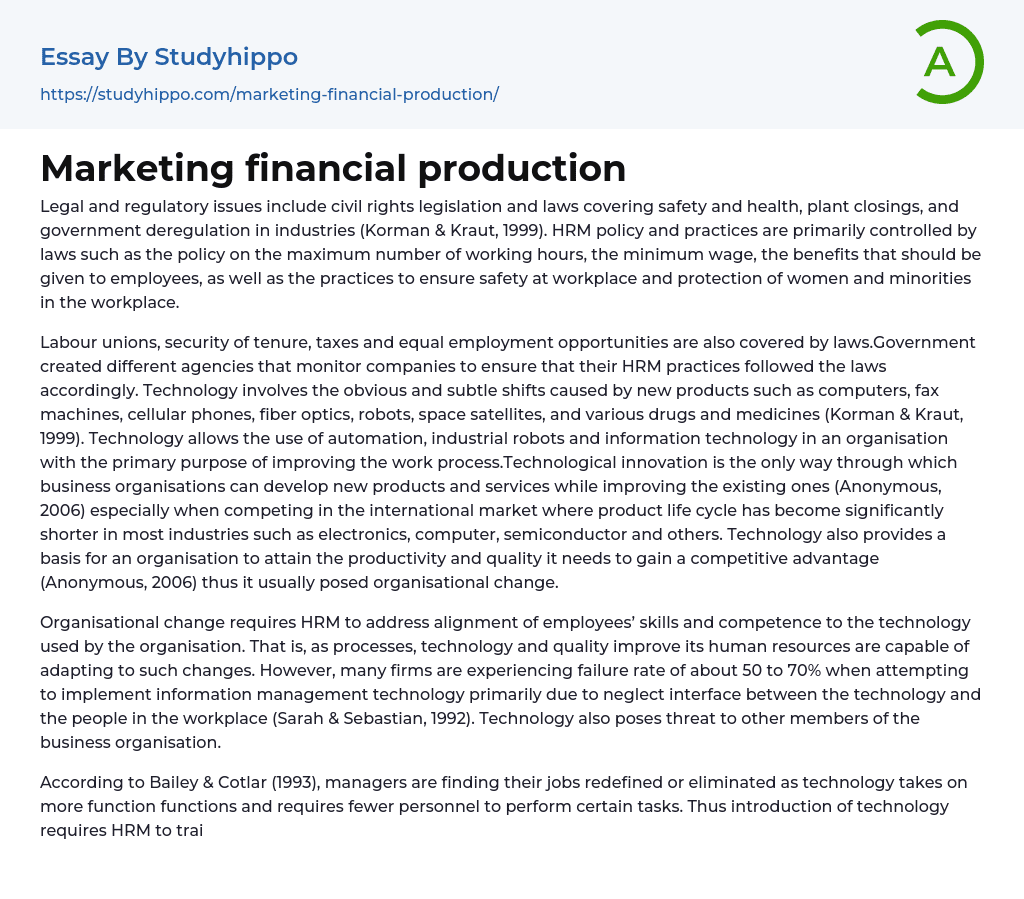Both legal and regulatory concerns encompass civil rights statutes and safety and health regulations, plant closures, and industry deregulation enacted by the government (Korman & Kraut, 1999). The policies and actions of HRM are largely governed by laws that enforce the maximum limit of working hours, minimum wage standards, employee benefits, workplace safety measures, and the safeguarding employee rights of women and minorities.
Laws cover a range of areas, including labour unions, security of tenure, taxes, and equal employment opportunities. The government has established various agencies to monitor companies and ensure compliance with HRM regulations. Technology has brought about noticeable and subtle changes, with the introduction of new products such as computers, fax machines, cellular phones, fiber optics, robots, space satellites, and medicines. Automation, industrial robots, and information technology are used to improve work processes. Technologica
...l innovation enables businesses to develop new products and services while enhancing existing ones, which is crucial for competing in the international market where product life cycles are often shorter. Technological advancement can also help organizations improve productivity and quality to gain a competitive advantage; however, it may lead to organizational change.
HRM must ensure that employees' skills and competence align with the technology employed by the organisation. This is necessary for successful organisational change, as employees must be able to adapt to improvements in processes, technology, and quality. Despite this, many firms face failure rates of 50 to 70% when implementing information management technology due to neglect of the interface between technology and employees in the workplace (Sarah ; Sebastian, 1992). Furthermore, technology can also pose a threat to other members of the business organisation.
Managers are having their jobs changed
or removed due to technology taking on more functions and needing fewer personnel for certain tasks, as reported by Bailey ; Cotlar (1993). Consequently, HRM must enhance the technological skills and competence of all employees throughout the organization. Employee development can entail training for new equipment usage, techniques for the most recent production processes, and learning about new managerial practices. Korman ; Kraut (1999) mention attitudes and values as their fifth factor, referring to a range of subjects such as the psychological contracts established with employers, beliefs concerning careers and commitment, opinions about extending employer benefits to unmarried partners, and more. This element constitutes part of an organization's internal environment rather than its external environment.
HRM practices are motivated by attitudes and values that influence how employees are managed. The attitudes and values of workers determine their needs and what will keep them content in their jobs. However, as these attitudes and values shift, employees' needs change as well and the motivational practices used by HRM can become less effective. For instance, if a single male employee gets married, his needs will likely change. While short-term financial rewards may have been motivating before, long-term rewards like benefits and promotions become more enticing.
Part of HRM involves managing the psychological contract, which is the mutual promises and obligations between the individual and the organization in the employment relationship. According to Herriot ; Pemberton (1997), effective communication is necessary for this management. Schalk ; Rousseau (2001) stated that managing psychological contracts is important for creating a workplace of trust and developing "people-building" organizations. HRM must determine the personal objectives and needs of employees to effectively meet both parties' objectives.
Managing organizational behavior and psychological contracts leads to the creation of a company culture and organizational identification, which encourage employee commitment and cooperation.
In conclusion, the operations of human resource management are influenced by both the internal and external environment of a business organization. The practices of HRM take into account the changes in the external and internal environment of a firm, and this is dependent on how the entire organization including other areas like marketing, financial, and production address such changes. References cited include Armstrong M.'s (1999) "A Handbook of Human Resource Management Practice," Beardwell ; Holden's (1997) "Human Resource Management: A Contemporary Perspective," and Briscoe, Dennis, & Schuler's (2004) "International Human Resource Management: Policies & Practices for the Global Enterprise."
McGraw-Hill, Inc. published Cascio's book "Managing Human Resources: Productivity, Quality of Work Life, Profits" in New York in 1992 under the imprint Routledge.
- Performance essays
- Human Resources essays
- Recruitment essays
- Code of Ethics essays
- Organizational Behavior essays
- Dress Code essays
- Safety essays
- Conflict essays
- Qualities essays
- Advertising essays
- Audience Theory essays
- Competitor Analysis essays
- Consumer essays
- Marketing Management essays
- Marketing Mix essays
- Marketing Plan essays
- Marketing Research essays
- Marketing Strategy essays
- Point Of Sale essays
- Price essays
- Procurement essays
- Product essays
- Product Differentiation essays
- Promotion essays
- Promotion And Marketing Communications essays
- Retailing essays
- Trademark essays
- Anheuser-busch essays
- Brands essays
- Detergent essays
- Product Placement essays
- Research Design essays
- New Product Development essays
- Advertisement essays
- Brand essays
- Sales Promotion essays
- Advertising campaign essays
- Consumer behaviour essays
- Offer And Acceptance essays
- Wal-Mart essays
- Discover essays
- American Dream essays
- Barriers To Entry essays
- Capitalism essays
- Central Bank essays
- Compensation essays
- Consumerism essays
- Economic Development essays
- Economic Growth essays
- Economic Inequality essays




